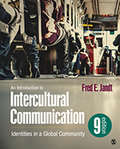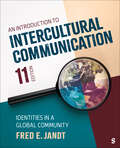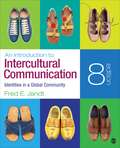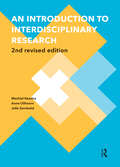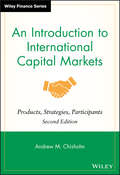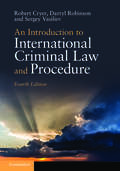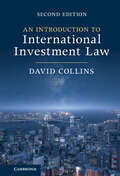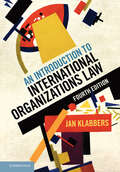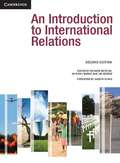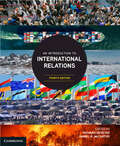- Table View
- List View
An Introduction to Intercultural Communication: Identities in a Global Community
by Fred E. Jandt“One of the best textbooks in intercultural communication for undergraduate students” —Mo Bahk, California State University, San Bernardino How does the Syrian refugee crisis, the election of Donald Trump, and the increasing number of “walls” being built to control immigration affect our ability to communicate and function across cultures? The highly anticipated Ninth Edition of An Introduction to Intercultural Communication prepares today’s students to successfully navigate our increasingly global community by integrating major current events into essential communication skills and concepts. To spark student interest, award-winning professor and best-selling author Fred E. Jandt offers unique insights into intercultural communication, at home and abroad, through an emphasis on history, culture, and popular media. Each chapter integrates material on social media, as well as extensive new examples from recent international news and events. Throughout the text, Jandt reinforces the important roles that our own stories, personal experiences, and self-reflection play in building our intercultural understanding and competence. New to the Ninth Edition New material on religion and identity, gender identity, and gender expression enables readers to explore the most current coverage on modern theories. Focus on Skills boxes have been expanded to include more activities that provide students with additional practice of intercultural communication skills. Focus on Technology boxes illustrate the impact of the newest communication technology on intercultural encounters. The popular map program provide students with additional context for discussion of cultures and regions across the globe and dynamic data displays that are popular with students. Give your students the SAGE edge! SAGE edge offers a robust online environment featuring an impressive array of free tools and resources for review, study, and further exploration, keeping both instructors and students on the cutting edge of teaching and learning. Learn more at edge.sagepub.com/jandt9e
An Introduction to Intercultural Communication: Identities in a Global Community
by Fred E. Jandt“One of the best textbooks in intercultural communication for undergraduate students” —Mo Bahk, California State University, San Bernardino How does the Syrian refugee crisis, the election of Donald Trump, and the increasing number of “walls” being built to control immigration affect our ability to communicate and function across cultures? The highly anticipated Ninth Edition of An Introduction to Intercultural Communication prepares today’s students to successfully navigate our increasingly global community by integrating major current events into essential communication skills and concepts. To spark student interest, award-winning professor and best-selling author Fred E. Jandt offers unique insights into intercultural communication, at home and abroad, through an emphasis on history, culture, and popular media. Each chapter integrates material on social media, as well as extensive new examples from recent international news and events. Throughout the text, Jandt reinforces the important roles that our own stories, personal experiences, and self-reflection play in building our intercultural understanding and competence. New to the Ninth Edition New material on religion and identity, gender identity, and gender expression enables readers to explore the most current coverage on modern theories. Focus on Skills boxes have been expanded to include more activities that provide students with additional practice of intercultural communication skills. Focus on Technology boxes illustrate the impact of the newest communication technology on intercultural encounters. The popular map program provide students with additional context for discussion of cultures and regions across the globe and dynamic data displays that are popular with students. Give your students the SAGE edge! SAGE edge offers a robust online environment featuring an impressive array of free tools and resources for review, study, and further exploration, keeping both instructors and students on the cutting edge of teaching and learning. Learn more at edge.sagepub.com/jandt9e
An Introduction to Intercultural Communication: Identities in a Global Community
by Fred E. JandtAn Introduction to Intercultural Communication equips students with the knowledge and skills to be competent and confident intercultural communicators. Best-selling author Fred E. Jandt guides readers through key concepts and helps them connect intercultural competence to their own life experiences in order to enhance understanding. Employing his signature accessible writing style, Jandt presents balanced, up-to-date content in a way that readers find interesting and thought-provoking. The Tenth Edition gives increased attention to contemporary social issues in today’s global community such as gender identifications, social class identity, and immigration and refugees. Included with this title: The password-protected Instructor Resource Site (formally known as SAGE Edge) offers access to all text-specific resources, including a test bank and editable, chapter-specific PowerPoint® slides.
An Introduction to Intercultural Communication: Identities in a Global Community
by Fred E. JandtAn Introduction to Intercultural Communication equips students with the knowledge and skills to be competent and confident intercultural communicators. Best-selling author Fred E. Jandt guides readers through key concepts and helps them connect intercultural competence to their own life experiences in order to enhance understanding. Employing his signature accessible writing style, Jandt presents balanced, up-to-date content in a way that readers find interesting and thought-provoking. The Tenth Edition gives increased attention to contemporary social issues in today’s global community such as gender identifications, social class identity, and immigration and refugees. Included with this title: The password-protected Instructor Resource Site (formally known as SAGE Edge) offers access to all text-specific resources, including a test bank and editable, chapter-specific PowerPoint® slides.
An Introduction to Intercultural Communication: Identities in a Global Community
by Fred E. JandtAn Introduction to Intercultural Communication prepares students to successfully navigate our increasingly interconnected global community by introducing essential communication skills and concepts with the goal of cultivating intercultural communication competencies when interacting with different cultures and ethnic groups. Best-selling author Fred E. Jandt offers students unique insights into intercultural communication, at home and abroad, through a focus on history, culture, and popular media. Emphasis is also placed on the important roles that stories, personal experiences, and self-reflection play in building our intercultural understanding and competence. The Eleventh Edition presents the most extensive revision of the text, including tying chapter learning objectives to the content, a new "Point/Counterpoint" feature to present both sides of controversial issues in intercultural communication to aid in developing critical thinking skills, and current examples that speak to the changing dynamics of our global community.
An Introduction to Intercultural Communication: Identities in a Global Community
by Fred E. JandtAn Introduction to Intercultural Communication prepares students to successfully navigate our increasingly interconnected global community by introducing essential communication skills and concepts with the goal of cultivating intercultural communication competencies when interacting with different cultures and ethnic groups. Best-selling author Fred E. Jandt offers students unique insights into intercultural communication, at home and abroad, through a focus on history, culture, and popular media. Emphasis is also placed on the important roles that stories, personal experiences, and self-reflection play in building our intercultural understanding and competence. The Eleventh Edition presents the most extensive revision of the text, including tying chapter learning objectives to the content, a new "Point/Counterpoint" feature to present both sides of controversial issues in intercultural communication to aid in developing critical thinking skills, and current examples that speak to the changing dynamics of our global community.
An Introduction to Intercultural Communication: Identities in a Global Community (Eighth Edition)
by Fred E. Edmund JandtAn Introduction to Intercultural Communication: Identities in a Global Community prepares today's students to successfully navigate our increasingly global community. Fred E. Jandt introduces essential communication skills and concepts that will empower readers to interact successfully with different cultures and ethnic groups. To spark student interest, Jandt offers readers unique insights into intercultural communication, at home and abroad, through an emphasis on history, culture, and popular media. Each chapter integrates material on social media, as well as extensive new examples from recent international news and events. Throughout the text, Jandt reinforces the important roles that stories, personal experiences, and self-reflection play in building our intercultural understanding and competence. The Eighth Edition adds depth to the coverage of theory and includes two new features: Focus on Skills provides expanded coverage of intercultural communication in practice, while Focus on Technology illustrates the impact of new communication technology on intercultural encounters. The new edition also introduces a new map program to provide students with additional context for discussion of cultures and regions across the globe.
An Introduction to Interdisciplinary Research: 2nd Revised Edition (Perspectives on Inter- and Transdisciplinarity)
by Machiel Keestra Anne Uilhoorn Jelle ZandveldWe are increasingly realizing that, as a result of technological developments and globalization, problems are becoming so complex that they can only be solved through cooperation between scientists from different disciplines. Healthcare, climate change, food security, globalization, and quality of life are just a few examples of issues that require scientists to work across disciplines. In many cases, extra-academic stakeholders must be involved in order to arrive at robust solutions. Young academics are being called on to step beyond the boundaries of traditional disciplines to contribute to addressing fundamental, often societal problems. As a result of these developments, an interdisciplinary approach is becoming increasingly necessary and popular in higher education. Students need to learn more about how to integrate and apply knowledge, methods, and skills from different fields. The crucial step of integration within interdisciplinary research is treated extensively in this textbook, which contains a comprehensive ‘interdisciplinary integration toolbox’. In addition, students must learn to collaborate in teams. An Introduction to Interdisciplinary Research serves as a systematic manual to guide students through this interdisciplinary research process.
An Introduction to Intermediate and Advanced Statistical Analyses for Sport and Exercise Scientists
by Nicholas D. Myers Nikos NtoumanisNtoumanis and Myers have done sport and exercise science researchers and students a tremendous service in producing An Introduction to Intermediate and Advanced Statistical Analyses for Sport and Exercise Scientists. This book has an outstanding compilation of comprehensible chapters dealing with the important concepts and technical minutia of the statistical analyses that sport and exercise science scholars use (or should be using!) in their efforts to conduct meaningful research in the field. It is a resource that all sport and exercise scientists and their students should have on their book shelves. Robert Eklund, School of Sport, University of Stirling, UK Motivating, to have a statistics text devoted to enabling researchers studying sport and exercise science to apply the most sophisticated analytical techniques to their data. Authors hit the mark between using technical language as necessary and user-friendly terms or translations to keep users encouraged. Text covers traditional and well-used tools but also less common and more complex tools, but always with familiar examples to make their explanations come alive. As a dynamic systems theorist and developmentalist, I would love to see more researchers in my area create study designs that would enable the use of tools outlined here, such as multilevel structural equation modeling (MSEM) or mediation & moderation analyses, to uncover cascades of relations among subsystems contributing to motor performance, over time. This text can facilitate that outcome. Beverly D. Ulrich, School of Kinesiology, University of Michigan, USA The domain of quantitative methods is constantly evolving and expanding. This means that there is tremendous pressure on researchers to stay current, both in terms of best practices and improvements in more traditional methods as well as increasingly complex new methods. With this volume Ntoumanis and Myers present a nice cross-section of both, helping sport and exercise science researchers to address old questions in better ways, and, even more excitingly, to address new questions entirely. I have no doubt that this volume will quickly become a lovingly dog-eared companion for students and researchers, helping them to continue to move the field forward. Gregory R. Hancock, University of Maryland and Center for Integrated Latent Variable Research (CILVR), USA
An Introduction to International Arbitration
by Ilias BantekasThis concise yet comprehensive textbook introduces the reader to the law and practice of international arbitration. Arbitration is a complex field due to the variety of disciplines involved and necessitates an approach that takes nothing for granted. Written by a renowned scholar and practitioner, this book explains the divergent issues of civil procedure, contracts, conflict of laws, international law amongst others in an accessible manner. Focusing mainly on international commercial arbitration, the book also features a distinct chapter on consumer and online arbitration and an equally comprehensive chapter on international investment arbitration.
An Introduction to International Capital Markets
by Andrew M. ChisholmFully revised and updated from the hugely popular first edition, this book is an accessible and convenient one-volume introduction to international capital markets, ideal for those entering or planning to enter investment banking or asset management. As well as serving as an invaluable reference tool for professionals already working in the industry looking to extend their knowledge base it will also benefit all those working in trading, sales and support roles.Describing how the key products and markets work, who the principle participants are and their overall goals and objectives, Andrew Chisholm provides a thorough overview of the global capital markets. The book covers a wide range of equity, debt, foreign exchange and credit instruments as well as the principal derivative products. In a step-by-step fashion, making extensive use of real world cases and examples, it explains money markets, foreign exchange, bond markets, cash equity markets, equity valuation techniques, swaps, forwards, futures, credit derivatives, options, option risk management and convertible bonds. An extensive glossary also explains concisely many of the 'jargon' expressions used in the financial markets.Boasting an international focus, examples are drawn from major international markets around the world. It makes extensive use of numerical examples and case studies to help explain a wide range of cash and derivative products used in the capital markets business. It covers both debt and equity products and includes new material on credit products such as collateralized debt obligations and credit derivative structures; equity fundamental analysis, portfolio theory and convertible bonds. Market data has been fully updated from the first edition and recent events such as the 'credit crisis' are discussed.
An Introduction to International Criminal Law and Procedure
by Robert Cryer Håkan Friman Darryl Robinson Elizabeth Wilmshurst Robert Cryer Håkan Friman Darryl RobinsonThis market-leading textbook gives an authoritative account of international criminal law, and focuses on what the student needs to know - the crimes that are dealt with by international courts and tribunals as well as the procedures that police the investigation and prosecution of those crimes. The reader is guided through controversies with an accessible, yet sophisticated approach by the author team of four international lawyers, with experience both of teaching the subject, and as negotiators at the foundation of the International Criminal Court and the Rome conference. It is an invaluable introduction for all students of international criminal law and international relations, and now covers developments in the ICC, victims' rights, and alternatives to international criminal justice, as well as including extended coverage of terrorism. Short, well chosen excerpts allow students to familiarise themselves with primary material from a wide range of sources. An extensive package of online resources is also available.
An Introduction to International Criminal Law and Procedure
by Robert Cryer Håkan Friman Darryl Robinson Elizabeth Wilmshurst Robert Cryer Håkan Friman Darryl RobinsonThis market-leading textbook gives an authoritative account of international criminal law, and focuses on what the student needs to know - the crimes that are dealt with by international courts and tribunals as well as the procedures that police the investigation and prosecution of those crimes. The reader is guided through controversies with an accessible, yet sophisticated approach by the author team of four international lawyers, with experience both of teaching the subject, and as negotiators at the foundation of the International Criminal Court and the Rome conference. It is an invaluable introduction for all students of international criminal law and international relations, and now covers developments in the ICC, victims' rights, and alternatives to international criminal justice, as well as including extended coverage of terrorism. Short, well chosen excerpts allow students to familiarise themselves with primary material from a wide range of sources. An extensive package of online resources is also available.
An Introduction to International Criminal Law and Procedure
by Robert Cryer Darryl Robinson Sergey VasilievWritten by a team of international lawyers with extensive academic and practical experience of international criminal law, the fourth edition of this leading textbook offers readers comprehensive coverage and a high level of academic rigour while maintaining its signature accessible and engaging style. Introducing the readers to the fundamental concepts of international criminal law, as well as the domestic and international institutions that enforce that law, this book engages with critical questions, political and moral challenges, and alternatives to international justice. Suitable for undergraduate and postgraduate students, academics and practitioners in the field, and cited by the International Criminal Tribunal for Yugoslavia, the International Criminal Court, the Special Court for Sierra Leone, the Extraordinary Chambers in the Courts of Cambodia, and the highest courts in domestic systems, this book is a must-read for anyone interested in learning more about international criminal law.
An Introduction to International Criminal Law and Procedure
by Darryl Robinson Sergey Vasiliev Valerie Oosterveld Elies van SliedregtBuilding on the success of previous editions (Cryer et al.), this popular textbook is now expanded and updated in a 5th edition featuring two new co-authors, Elies van Sliedregt and Valerie Oosterveld. A market leader and one of the most globally trusted textbooks on international criminal law, it is known for its accessible and engaging tone and for an even-handed approach that is both critical and constructive. Comprehensively updated and rewritten, this new edition introduces readers to the main concepts of international criminal law, as well as the domestic and international institutions that enforce it, and addresses the latest challenges and controversies surrounding the International Criminal Court. Written by a team of international criminal lawyers who have extensive academic and practical experience in the field, the book engages with critical questions, political and moral challenges, and alternatives to international justice. It contains helpful references to other literature, making it a valuable research resource.
An Introduction to International Economics
by Kenneth A. ReinertThis book is designed for a one-semester or two-semester course in international economics, primarily targeting non-economics majors and programs in business, international relations, public policy and development studies. It has been written to make international economics accessible to wide student and professional audiences. The book assumes a minimal background in microeconomics and mathematics and goes beyond the usual trade-finance dichotomy to give equal treatment to four 'windows' on the world economy: international trade, international production, international finance and international development. It takes a practitioner point of view rather than a standard academic view, introducing the student to the material they need to become effective analysts in international economic policy. The website for the text is found at http://iie.gmu.edu.
An Introduction to International Institutional Law
by Jan KlabbersInternational institutions are powerful players on the world stage, and every student of international law requires a clear understanding of the forces that shape them. For example, with increasing global influence comes the need for internal control and accountability. This thought-provoking overview considers these and other forces that govern international institutions such as the UN, EU and WTO, and the complex relationship that exists between international organizations and their member states. Covering recent scholarly developments, such as the rise of constitutionalism and global administrative law, and analysing the impact of important cases, such as the ICJ's Genocide case (2007) and the Behrami judgment of the European Court of Human Rights (2007), its clarity of explanation and analytical approach allow students to understand and think critically about a complex subject.
An Introduction to International Investment Law
by David CollinsThis insightful and accessible introduction provides students and practitioners with a comprehensive overview of the increasingly important discipline of international investment law. Focusing primarily on the legal principles contained in the growing body of international investment agreements, this book covers the core concepts of the discipline with attention given to their relation to each other and to the manner in which they have been developed through arbitration case law. The context of each legal principle is explored along with a consideration of some of the major debates and emerging criticisms. Avoiding extensive case extracts, this book adopts an engaging and succinct narrative style which allows readers to advance their understanding of the topic while examining the legal principles with academic rigour and discerning commentary.
An Introduction to International Investment Law
by David CollinsThis insightful and accessible introduction provides students and practitioners with a comprehensive overview of the increasingly important discipline of international investment law. Focusing primarily on the legal principles contained in the growing body of international investment agreements, this book covers the core concepts of the discipline, with attention given to their relation to each other and to the manner which they have developed through arbitration case law. The context of each legal principle is explored, along with a consideration of some of the major debates and emerging criticisms. Avoiding extensive case extracts, this book adopts an engaging and succinct narrative style which allows readers to advance their understanding of the topic while examining the legal principles with academic rigour and discerning commentary.
An Introduction to International Migration Studies: European Perspectives (IMISCOE Textbooks)
by Marco MartinielloFocusing mainly on the European experience including Eastern Europe, this important volume offers an advanced introduction to immigrant incorporation studies from a historical, empirical and theoretical perspective. Beyond incorporation theories, renowned scholars in the field explore incorporation in action in different fields, policy issues and normative dimensions. An advanced introduction to international migration studies from a historical, empirical and theoretical perspective. Types of migration and migration regulation are explored by respected scholars in the field. Focusing mainly on the European experience, including Eastern Europe.
An Introduction to International Negotiation: Concepts, Processes and Research
by Bertram I. SpectorThis textbook provides a comprehensive introduction to the international negotiation system – its key elements and processes, what major issues and challenges it faces, and its impacts on international relations. As a major catalyst of global dynamics, negotiation is used to resolve conflicts and promote cooperation peacefully. It is important to understand how it works. First, the book analyzes the principal factors that interact to move the negotiation system forward – the issues and context, actors, structures, strategies, and outcomes. Then, the discussion considers the four basic subprocesses of international negotiation – getting to the table, conducting negotiations, developing implementation plans, and continuing negotiations in the post-agreement period. Relevant research is presented in each chapter to elaborate on these dynamics and offer case studies of negotiations addressing intrastate conflict, the environment, terrorism, anti-corruption and good governance, and post-agreement issues. In addition, the book examines major conflictual conundrums currently facing the world in the Middle East and Ukraine to explore opportunities for negotiated solutions. Providing a solid mix of theory, research, and real-world cases that offers readers a comprehensive appreciation of the field and how it is used on a practical level, this is an excellent basic text for courses on international relations, peace studies, conflict resolution, and international negotiations, and a useful resource for researchers, policymakers, and practitioners.
An Introduction to International Organizations Law
by Jan KlabbersThe third edition of this market-leading textbook (previously called An Introduction to International Institutional Law) is written in a clear, three-part structure. It is centred on the dynamics of the relationships between international organisations and their organs, staff, and the outside world. It discusses the essential topics of the law of international organisations, including powers, finances, and privileges and immunities, as well as membership rules, institutional structures, and accountability. The newly revised text has been updated extensively to reflect the entry into force of the EU's Lisbon Treaty (and Croatia's accession) and new articles on the responsibility of international organisations. The chapters have also been reorganised for further clarity. Two new chapters, on the international civil service and the relations between organisations and other institutions, respectively, have been added.
An Introduction to International Organizations Law
by Jan KlabbersThe fourth edition of this market-leading textbook offers students a clear framework for understanding the practice and logic of International Organizations Law. It is structured around the three defining relationships IOs engage in – namely, with their member states, with their organs and staff, and with the outside world. These different dynamics give rise to different concerns, which each help to explain the logic behind international institutional law. The text also discusses the essential topics of the law of IOs, including powers and finances, privileges and immunities, institutional structures, and accountability. By demonstrating how the theory works in practice, with recent examples, students will observe the impact and significance of International Organizations Law. Updated with the latest case law and literature, this new edition also contains discussions of the withdrawal of Israel and the US from UNESCO, Brexit, and the Covid-19 pandemic, and how these affect the law of international organizations.
An Introduction to International Relations
by Richard Devetak Jim George Anthony BurkeInvaluable to students and those approaching the subject for the first time, An Introduction to International Relations, Second Edition provides a comprehensive and stimulating introduction to international relations, its traditions and its changing nature in an era of globalisation. Thoroughly revised and updated, it features chapters written by a range of experts from around the world. It presents a global perspective on the theories, history, developments and debates that shape this dynamic discipline and contemporary world politics. Now in full-colour and accompanied by a password-protected companion website featuring additional chapters and case studies, this is the indispensable guide to the study of international relations.
An Introduction to International Relations
by Richard Devetak Daniel R. McCarthyInternational Relations is a dynamic discipline, evolving in response to contemporary world politics. An Introduction to International Relations offers a foundational explanation of the theories, systems, actors and events that shape external relations between nations in today's global society. This edition retains the existing structure, grouping chapters on theories, international history and the 'traditional' and 'new' agendas, while acknowledging that these exist alongside one another and intersect in complex ways. The text has been comprehensively updated and includes new chapters on postcolonialism, the international politics of cyberspace, global public health and the futures of International Relations. New postcard boxes and case studies present contemporary examples of international relations in action, and discussion questions at the end of every chapter promote student engagement. Written by an author team of leading academics from Australia, New Zealand and around the world, An Introduction to International Relations remains a fundamental guide for students of international relations.
